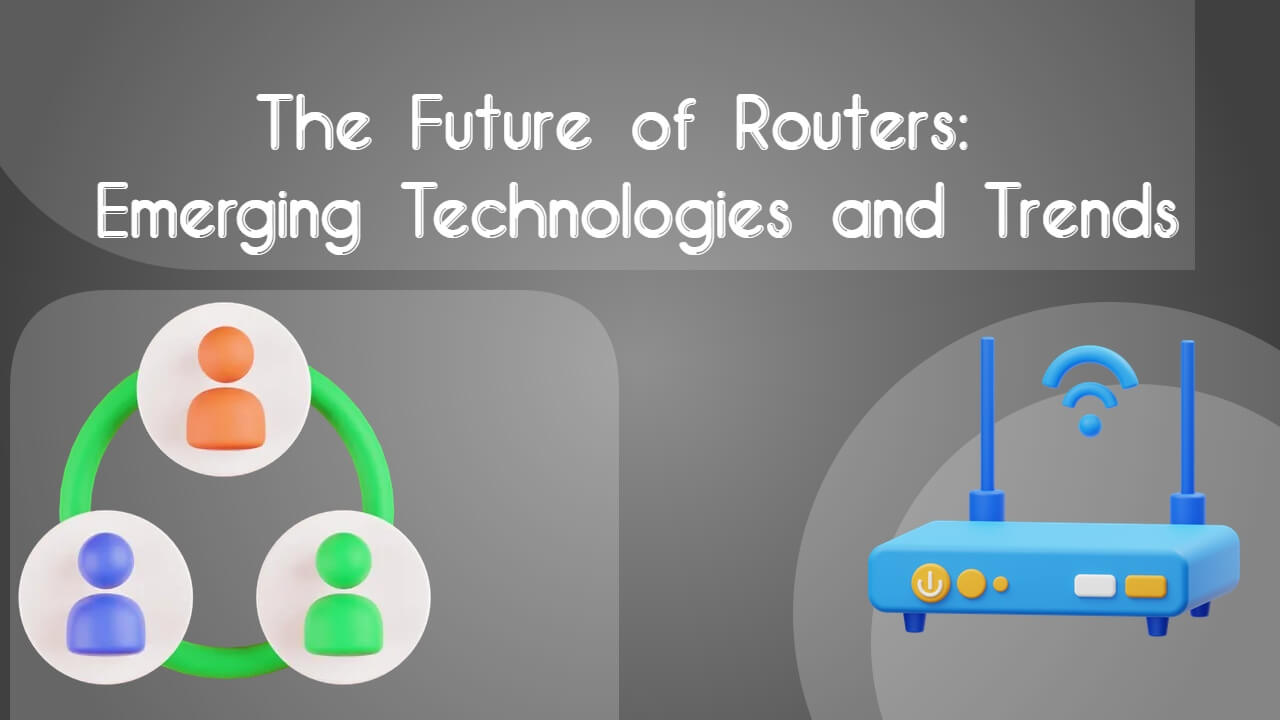03 Aug

“Eating organic for good health and spending your day sitting down using a wireless computer that is next to a WiFi router is a classic case of Yin & Yang.” ? Steven Magee
The future of routers is very promising. So before we leap into the future of routers, let me start briefing you on what routers are!
Routers are devices that connect to a single network or multiple subnetworks.
In this post, you’ll get an insight into the future of routers. You will also get to know about emerging technologies along with the trends.
Let's get on to the article for a comprehensive understanding!
How Does A Router Work?
A router is a computer networking device that sends data packets between computer networks. When data is forwarded through networks, such as web pages or emails, as data packets, every bit of information is secure and protected against cyber threats.
The routers are watchdogs over different networks. It primarily manages the traffic and connects multiple devices to perform within the networks. They decide the best route for your information to travel, thereby connecting your business to the world.
Now that you have understood the work of a router read on to know the types of routers you may need. This will help you choose the right equipment for your home or office.
Types of Routers in Networks
Routers are found in broadband routers and wireless routers. These routers can be used both for home and office purposes. Now let's detail the information regarding them.
Single Wire Routers
SCR are routers connected to the network via a single wire. It channelizes radio frequency from a dish or antenna to an immediate frequency. Wire routers share data over cable with a 10/100/1000Mbps bandwidth.
Local Area Networks (LANs) have been considered old-generation routers since the boom of wireless routers. But you will still observe SCR services for Computers and Laptops used in banks, schools, colleges, and offices.
Wireless Routers
These are network nodes that are mainly used in homes, offices, and public places. Wireless LANs are local area networks with no limit to the users.
However, these routers are difficult to connect, so wireless routers gradually replace them. Whereas wireless routers connect with heavy loads and are easy to use.
Now let's explore the other types of routers.
Other Types of Routers
Now, let’s look at the other types of routes that include edge routers, core routers, subscriber routers, inter-provider border routers, broadband routers, and VPNs.
As mentioned earlier, this section describes different routes for a better vision.
Edge routers
They appear as wire and wireless forms that distribute data between single or more networks placed at the edge of the ISP. They are mutually used in Border Gateway Protocol or large enterprises.
Edge routers allow dynamic connectivity, security, and other IT services in a compact form. They are power-efficient and easy enough for generalized people to connect.
The benefits of using the edge platform provide you with quality service, remote access, and flexibility.
Core Routers
Cores are powerful computer routers used for large networks. They are the fastest, most powerful, and most premium routers available in the market. Since these are expensive routers, they are limited to ISPs and large institutions.
Core routers are the network's backbone, capable of heavy data transferring and quality performance. These routers distribute data packets to the host within a network. They extensively operate data at a much greater speed.
Subscriber Edge Router
Subscriber edge routers are responsible for access, including authentication, authorization, and accounting (AAA) for traffic and management.
They provide virtual private networks (VPNs), firewalls, and quality of service (QoS) services to ensure users receive reliable and secure network systems.
Subscriber Edge Router functions in two ways. One with Border Gateway Protocol that connects one autonomous to another and the other as ASes connects network to network.
Inter-Provider Border Router
They are used for interconnecting Internet Service providers. The Inter-Provider Border Gateway Protocol maintains relations between the devices with other BGP routers to other ASes for safe data processing and quality performance.
A border router connects an organization's internal network through the Internet. It is typically used in enterprise networks and manages traffic between internal and Internet networks.
Broadband Routers
These routers are internet connectivity providers that associate via DSL, ADSL, Fibre Optic, Coaxial, wireless, and other high-speed modes, allowing internet access to multiple users.
Here the router combines its features with a network switch, Dynamic Host Configuration Protocol (DHCP) server, and firewall within a single device.
It generally has several local area network (LAN) ports and integral security features. You’ll find many broadband routers as WiFi routers with wireless connectivity.
VPN routers
Virtual Private Network (VPN) protects your online identity, IP address, and other malware practices from third-party interventions. VPN protects your internet traffic with AES (advanced encryption standard) encryption, which keeps your data and identity safer.
VPN includes other facilities such as:
- Login only for the first time.
- Better Adaptability can be incorporated into devices externally through a VPN router.
- Unlimited Connectivity can be used on unlimited devices.
- Unblocking Applications and Content through an encrypted VPN enables you to connect even in unrestricted countries.
The Future of Routers Emerging Technologies and Trends
To start with the future of routers, let’s understand the potential of routers in emerging technologies and trends that could impact our daily lives.
Internet of Things (IoT)
The Internet of Things (IoT) is an object connected physically to cyberspace for collecting and sharing data over the net. The device has increased the traffic in the network, resulting in growing demands for routers. They work effortlessly to manage traffic in the connected network interface.
Cloud Computing
Cloud computing is a software development service containing three types of cloud computing services, including IaaS, PaaS, and SaaS, for big data analytics, faster innovation, and scalable economies.
- Infrastructure as a Service (IaaS) is vital in the cloud computing service for virtual machines, storage, and networking.
- Platform as a Service (PaaS) has additional services and resources in managing cloud applications.
- Software as a Service (SaaS) is the complete cloud computing service the provider manages via Internet services.
Smart routers
Traditional routers provide internet service with a single access point. Smart routers, on the other side, are more advanced that come with additional features. It provides advanced security, parental controls, and network management.
These emerging technologies allow ASUS routers to connect to the desired band automatically. It identifies and mitigates the problems by ensuring stable connections.
Advanced security
They are an essential feature in emerging routers systems. Smart routers are designed to barricade malware practices. Unauthorized access includes preventing encryption of the network to protect sensitive data.
Software Defined Networking (SDN)
SDN centralizes the system management, making the network more secure and flexible. It uses application programming interfaces (APIs) to manage traffic on the network. Automating and directing traffic is more effortless and has led to the development of new technologies protocol.
Emerging Technologies
The emerging technologies or new technologies include Wi-FI 6 and 802.11ax, Light Fidelity Technology, the Internet of Things, Smart Home Devices, 5G Networks, and Integration. Let’s read that details down respectively.
Wi-Fi 6 and 802.11ax
As technology evolves, we constantly seek ways to improve network performance and efficiency. Wi-Fi 6, also known as 802.11ax, is a promising advancement in wireless networking.
It offers faster speeds, increased capacity, and reduces delays, thus allowing smoother streaming, gaming, and general internet use.
As routers become equipped with Wi-Fi 6, they'll be able to meet the demands of more devices and users online, offering more efficient and reliable connectivity.
Light Fidelity Technology
Li-Fi, or Light Fidelity, is an upcoming wireless technology that uses light to transmit data. Unlike traditional Wi-Fi, which uses radiofrequency waves, Li-Fi is not susceptible to interference from electromagnetic devices. The device can further lead to enhanced network performance and improved security systems.
As Li-Fi routers become more available, they could be a valuable addition to the existing Wi-Fi technology by offering an alternative networking solution for high-density and high-interference applications.
IoT and Smart Home Devices
The Internet of Things (IoT) has grown rapidly in recent years, with a broad range of smart home devices now connecting to our networks. Routers are crucial in managing these devices, ensuring the necessary resources and connectivity to function efficiently.
With the addition of IoT-focused technologies such as edge computing, future routers will be better equipped to handle the data and performance demands of smart home devices, making our daily lives even more connected and seamless.
5G Networks and Integration
The ongoing integration of 5G networks worldwide is another factor shaping the future of routers. 5G offers faster speeds, ultra-low latency, and boosting capacity compared to previous generations.
As 5G becomes more widespread, we can expect routers to evolve and integrate with new networks, ensuring a smooth transition for users and connected devices.
Additionally, integrating 5G into routers may lead to more advanced network management features and further enhance the capabilities of IoT and smart home devices.
By embracing these emerging technologies, routers of the near future will be able to better adapt to the ever-increasing demands on our networks. Integrating Wi-Fi 6, Li-Fi, and IoT advancements.
5G networks provide a consistently faster, more reliable, and more efficient experience for all users and connected devices. As new networking technologies continue to emerge, they will play a vital role in shaping the future of routers in the interconnected world.
Market Dynamics and Growth
We have observed significant growth in the global router market in recent years. The growth is attributed to rising demand for improved internet speeds and advanced security features.
The increasing number of connected devices, such as smartphones, smart homes, and IoT devices, has also contributed to the market growth. Another driving force is developing and implementing 5G networks and wireless technologies.
With the introduction of WiFi 6 and mesh networks, wireless routers and access points have become more efficient, expanding network coverage and providing a better user experience.
Industry players like Cisco, D-Link, ZTE, ASUS, and Huawei have also invested in innovations focused on enhancing signal strength, parental controls, and network expansion capabilities.
Furthermore, adopting automation and machine learning technology in routers has paved the way for secure and well-optimized network environments, propelling the growth rate further. The router market is expected to experience a significant Compound Annual Growth Rate (CAGR) over the forecast period.
Routers for Apple Devices 2023 !!
The article comprises a comprehensive analysis comparing 40 routers mentioning their features in the market. Here you can check Routers for Apple Devices, their price, features, and appropriateness in handling Apple devices; the final list is narrowed down to fit multiple scenarios. You will get to know the eight best routers for iPhone devices.
Conclusion
One of the critical aspects defining the future of routers is the continuous advancement in technology. Adopting cutting-edge technologies, such as artificial intelligence, machine learning, and the Internet of Things (IoT), is poised to revolutionize the capabilities and optimize the performance of routers.
Furthermore, enhanced security standards and energy efficiency are becoming increasingly important in focusing on sustainability and data protection. Integrating these essential features with emerging technologies and trends will undeniably elevate the functionality of routers and ensure they remain necessary to modern communication infrastructure.
The way we connect to the Internet and share data has the potential to enhance our daily lives. The exciting performance of the smart future of routers can help keep your network secure, reliable, and efficient. Investing in the latest router technology is a user-friendly experience.
.png)













Jay Pala